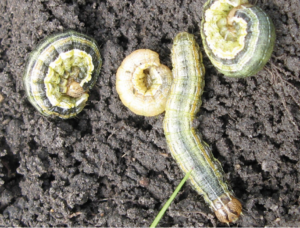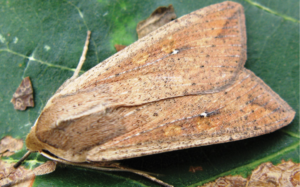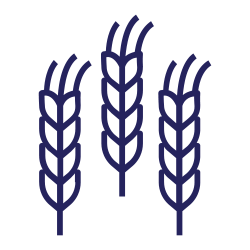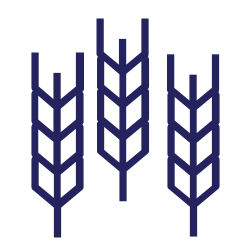Section Title
Scouting for Armyworms in Winter and Spring Cereals
- Wheat
- Winter Wheat
*Resource information sourced from Manitoba Agriculture’s armyworm factsheet
Armyworms (Mythimna unipuncta), sometimes called true armyworm, are a pest species that impact winter wheat, spring wheat, fall rye, barley, forage and pasture crops. Armyworm moths do not overwinter in Manitoba – they migrate from the southern U.S. to the Canadian Prairies. Moths travel to Manitoba between May and June through purposeful migration, but southern winds assist in moth transportation. Armyworms are especially an issue in winter cereals and early planted spring cereals, such as winter wheat and fall rye, because of their lush vegetative material earlier in the growing season. The vegetative material is a perfect habitat for armyworm moths to lay their eggs once they arrive in Manitoba. Eggs hatch roughly 7 – 14 days after they are laid. The armyworm larvae feed on leaves and foliage and sometimes clip heads, although head clipping isn’t as typical if foliage is abundant. Grasses are their preferred food source.
Figure 1: Armyworm larvae (left) and adult armyworm moth (right). Photos: Dr. John Gavloski.
Scouting for armyworms can be difficult. The first step is understanding armyworm larvae and moths’ identifying features:
Armyworm larvae
- Green to pale-yellow colour when young. Dark green to black colour when larvae mature.
- Pale orange, black and white strips along the side of their whole body.
- Prolegs (the short, fleshy legs on the abdomen) with a distinct dark ring on the outer side.
- The head capsule is brown with netted appearance.
- Distinctive “V” pattern on head capsule.
- 3 – 3.5 cm in length.
Armyworm moths
- Small white spot (size of pinhead) on each pale-brown forewing.
Scouting and spraying considerations
Through diligent scouting, armyworm levels should be determined at multiple spots within a field, with the number of armyworms per square foot guiding intervention decisions. Armyworms primarily feed at night, but specific scouting techniques can be deployed to ensure thorough scouting throughout the day:
- Pheromone-baited traps can be used to steer scouting efforts. Manitoba Agriculture runs a network of traps that are updated weekly from early May until late July. Trap results can be found here.
- Leaf blade skeletisation is a sign of young larvae feeding. Outer leaf notching and complete leaf defoliation can occur as armyworm larvae mature.
- Field margins, areas with dense stands, lodged areas and grassy weed patches should be scouted first.
Scouting at night
- Shake the plants, this will dislodge any armyworms on the plant. Count the number of armyworms in a square foot.
Scouting during the day
- Armyworms hide under crop debris, residue, and soil clods, and in soil cracks. Shake the plants in the area you are scouting, this will dislodge any armyworms on the plant. Look thoroughly through the soil surface at the base of the plants and count the number of armyworms in a square foot.
When scouting, determine armyworm maturity, if parasitism is extensive, and crop staging.
- Once armyworm larvae are fully grown and close to pupating the economic return for insecticide application is typically low, if any.
- Similarly, there is less economic benefit to insecticide application if the armyworm population is heavily parasitized. Cotesia (parasitic wasp) pupal cluster in wheat awns or small white eggs on the back of the armyworms head (parasitic fly eggs) are two identifiers that parasitism is occurring.
- Little benefit to spraying insecticide if plants are nearing or at physiological maturity.
Economic thresholds for insecticide applications
(Always read and follow product label instructions; reference the Manitoba Guide to Field Crop Protection 2024 for more information on specific products)
- Four or more armyworms per square foot in small grain cereals.
- Two or more armyworms per square foot if heads are being clipped.
If you decide to apply an insecticide there are a few things to note:
- Spray in the evening when armyworms are most active.
- Only infested patches might need to be sprayed, thus prudent scouting to determine infestation levels across the whole field is necessary.
Cultural control practices
- Reduce the habitat which attracts egg laying moths. Ex. Grassy weeds
Additional resources











